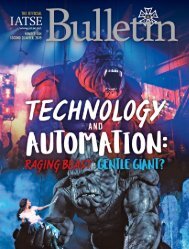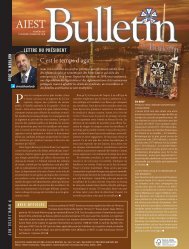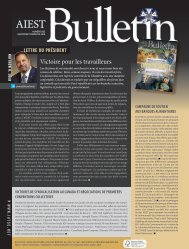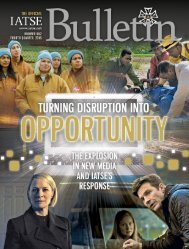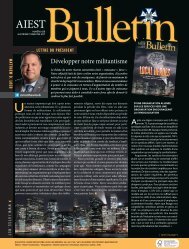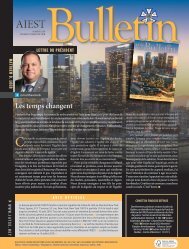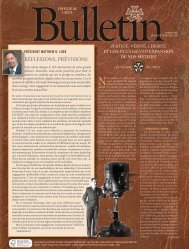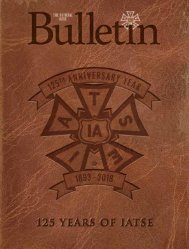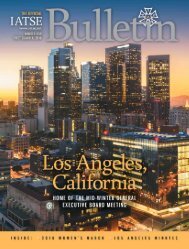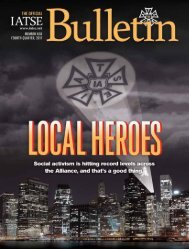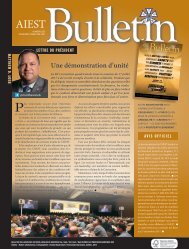IATSE 3rd 2019_web
Create successful ePaper yourself
Turn your PDF publications into a flip-book with our unique Google optimized e-Paper software.
positioned to withstand a serious economic<br />
downturn and will likely outperform<br />
while being 40% less volatile than<br />
our peer portfolios. The expected return<br />
is 0.6% above peers with a significantly<br />
lower equity allocation. The primary<br />
reason for the better return-risk ratio for<br />
the pension versus our peer portfolio is<br />
because of the lower equity and higher<br />
alternatives allocations.<br />
ARIS Investments summarized the<br />
study in six key takeaways. The pension<br />
has a long-term objective to achieve<br />
7.5% average net return with as little risk<br />
as possible. Risk is measured by volatility<br />
and probability of material loss. The<br />
Plan is currently structured to meet this<br />
objective. The Pension’s expected return<br />
is higher and volatility lower than the<br />
typical peer portfolio and the odds of<br />
material loss are markedly lower based<br />
on simulations going back to 1926. The<br />
primary reason the plan is more efficiently<br />
allocated than its peers is because<br />
it is more diversified. This doesn’t<br />
mean defensive. In fact, over 80% of the<br />
assets are invested to have an equity-like<br />
return. The pension is structured to produce<br />
better performance (higher return/<br />
lower risk) than equity-concentrated<br />
peer portfolios over the long term. Due<br />
to a lower equity allocation, it is likely to<br />
underperform during strong equity markets<br />
and outperform during economic<br />
downturns.<br />
President Loeb thanked the Directors<br />
for their report, noting that the Plans<br />
continue to grow as the combined hours<br />
continue to exceed projections. President<br />
Loeb noted that the stress test is significant<br />
because it indicates that, in the event<br />
of a market downturn, the Plans will<br />
continue to be in good shape. President<br />
Loeb concluded his remarks by thanking<br />
the Directors for their hard work.<br />
NU IMAGE<br />
General Counsel Samantha Dulaney<br />
and West Coast Associate Counsel Jacob<br />
J. White reported to the Board on Nu<br />
Image v. <strong>IATSE</strong>.<br />
General Counsel Dulaney noted that<br />
the facts of this case are extremely esoteric<br />
but at its most basic the case involved<br />
a dispute over Nu Image’s obligation to<br />
pay residuals on their productions.<br />
Despite clear language in the contracts<br />
requiring them to do so, Nu Image<br />
did not pay any residuals to the Motion<br />
Picture Industry plans from 2006 to<br />
2013. The MPI subsequently sued Nu<br />
Image for delinquent contributions. Nu<br />
Image then turned around and sued the<br />
<strong>IATSE</strong>, claiming that the International<br />
made negligent, or intentional misrepresentations<br />
during bargaining. Nu Image<br />
claimed that it relied on the representations<br />
of the International that it would<br />
not have to pay residuals. It sought indemnification<br />
from the International,<br />
essentially demanding that the International<br />
pay the residuals on their behalf.<br />
The International disputed these patently<br />
false claims.<br />
The International was confident<br />
throughout the litigation that Avi Lerner<br />
and Nu Image had no legal, or factual,<br />
basis for their lawsuit. The case percolated<br />
up from the California federal district<br />
court to the Ninth Circuit Court of<br />
Appeals, and finally to the United States<br />
Supreme Court. The International prevailed<br />
at every step, from summary judgment<br />
at the District Court, to confirmation<br />
of summary judgment by the Ninth<br />
Circuit, and, finally, to the Supreme<br />
Court’s decision to deny review. The case<br />
is now over.<br />
General Counsel Dulaney thanked<br />
David Rosenfeld, Bill Sokol, Michael<br />
Burstein, Lisl Soto, Roberta Perkins,<br />
and Monica Guizar from the Weinberg,<br />
Roger & Rosenfeld law firm, and Counsel<br />
White, for their work on the case.<br />
President Loeb thanked General<br />
Counsel Dulaney and Counsel White<br />
for their report, remarking that it is important<br />
for the members to hear reports<br />
like this so they know that the International<br />
will battle employers all the way<br />
to the Supreme Court when they know<br />
the battle is important. This employer<br />
did not want to pay residuals, which fund<br />
the health and pension plans for <strong>IATSE</strong><br />
members, and the <strong>IATSE</strong> will never back<br />
down in fighting for what is right.<br />
OSBURN VS. <strong>IATSE</strong><br />
SUPREME COURT CASE<br />
General Counsel Samantha Dulaney<br />
and West Coast Associate Counsel Jacob<br />
White gave the Board a status report concerning<br />
litigation filed in 2014 by Brother<br />
James Osburn and Sister Elizabeth Alvarez<br />
against the <strong>IATSE</strong> International,<br />
President Loeb and International Vice<br />
President Michael F. Miller, Jr. The facts<br />
and background of the litigation have<br />
been set forth in previous Bulletins and<br />
in the Proceedings of the 2017 Quadrennial<br />
Convention.<br />
Local 695 was placed into trusteeship<br />
in February of 2014 for violating the<br />
<strong>IATSE</strong> International Constitution. As a<br />
result of the receivership, all officers of<br />
Local 695 including Brother Osburn and<br />
Sister Alvarez were removed from their<br />
positions as Local officers. Some employ-<br />
THIRD QUARTER <strong>2019</strong> 93



